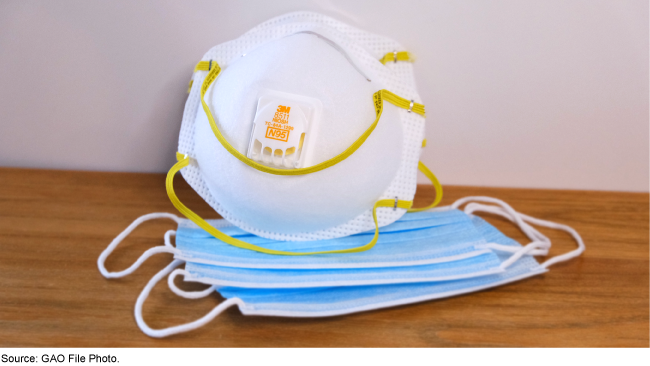VA Acquisition Management: Comprehensive Supply Chain Management Strategy Key to Address Existing Challenges
Fast Facts
The VA faced unexpected challenges with the COVID-19 pandemic, exposing problems in its supply chain management. In response, it took steps such as establishing central storage facilities for critical medical supplies.
The VA has several linked initiatives to update its supply chain. We testified that successful preparation for future health emergencies relies on a comprehensive supply chain management strategy. We recommended the VA update its strategy to ensure it is comprehensive and includes all ongoing efforts.
Addressing supply chain challenges will help the VA improve acquisition management, which we added to our High Risk List in 2019.

Highlights
What GAO Found
The Department of Veterans Affairs (VA) experienced challenges tracking and obtaining medical supplies in response to COVID-19, particularly in the early stages of the pandemic—underscoring the need for supply chain improvements and acquisition management efficiencies.
GAO's observations from its ongoing work show that VA is taking steps intended to help it better respond to future health emergencies through standing up Regional Readiness Centers (RRC) to act as central sources for critical medical supplies. VA also seeks to participate in the Defense Logistics Agency's (DLA) Warstopper program, which allows DLA to access critical supplies during an emergency. GAO's observations suggest VA has yet to address key questions about these new COVID-19 supply chain initiatives, such as:
RRCs: What range of supplies will they stock? Will VA use its Medical Surgical Prime Vendor program or other contracting mechanisms to supply the RRCs? How much funding will be needed?
Warstopper: How does DLA's Warstopper program link to RRCs? What range of supplies will Warstopper cover? How much funding will be needed?
The new initiatives and VA's ongoing modernization initiatives do not exist in isolation and are highly interrelated, with overlapping timelines (see figure). Delays and other changes in one initiative can affect the others. For example, VA plans to replace more than half of its supply chain management systems with the Defense Medical Logistics Standard Support system but the initial rollout was delayed due to challenges integrating the system with VA's financial systems.
VA lacks a comprehensive supply chain strategy for its various and interrelated supply chain management initiatives. Until it develops an overarching supply chain strategy and answers key questions, VA will not be able to fully address its high-risk acquisition management and ultimately better meet veterans' needs.
Simultaneous Selected Department of Veterans Affairs Supply Chain Modernization Initiatives

Why GAO Did This Study
In fiscal year 2020, VA received about $19.6 billion in supplemental appropriations for COVID-19-related needs and through February 2021 has spent about $1.1 billion on medical supplies and equipment. GAO testified in June 2020 and September 2020 that VA faced supply chain challenges, particularly in the early stages of the pandemic. Due in part to long-standing supply chain management issues that predated the pandemic, GAO added VA acquisition management to its High-Risk List in 2019. GAO's March 2021 High-Risk Update reported that VA has made limited progress in addressing its acquisition management challenges.
This statement discusses VA's progress toward modernizing its supply chain. This statement is largely based on information from six reports issued from 2017-2020 and observations from an ongoing review of VA's COVID-19 procurements.
To perform this work, GAO reviewed VA documentation and interviewed VA officials and medical center staff.
Recommendations
GAO has made 48 recommendations since 2015 to improve acquisition management at VA. VA agreed with those recommendations and has implemented 22 of them. In this statement, GAO is recommending that VA develop a comprehensive supply chain management strategy that, among other things, outlines how its various supply chain initiatives relate to each other.
Recommendations for Executive Action
| Agency Affected Sort descending | Recommendation | Status |
|---|---|---|
| Department of Veterans Affairs |
Priority Rec.
The Secretary of Veterans Affairs should ensure the Veterans Health Administration (VHA) Assistant Under Secretary for Health for Support develops a comprehensive supply chain management strategy that outlines how VHA's various supply chain initiatives are related to each other and to VA-wide initiatives. This strategy should link to VA's overall plans to address its broader acquisition management challenges and reflect key practices of organizational transformations, including an implementation plan with key milestones. (Recommendation 1) |
Open – Partially Addressed
VA officials agreed with this recommendation. As of February 2024, VA and VHA continue to collaborate to provide a completed Comprehensive Supply Chain Management strategy to GAO. In September 2023, VA signed a charter which appointed a program manager to oversee the modernization of the supply chain process within VA. In September 2023, VA also chartered an Enterprise Supply Chain Board (ESCB) to integrate VA's supply chain efforts under a single governing body to bring together the goals, governance structure, and roles and responsibilities of the ESC program. VA's Chief Acquisition Officer is leading efforts to develop an overarching strategy, but has yet to set a release date for the final strategy. VA has completed two phases of its process to develop this strategy, which include identifying the current state of its supply chain and conducting a gap analysis. VA's Office of Acquisition, Logistics, and Construction is also in the process of acquiring a new information technology capability to support its supply chain effort. To fully implement this recommendation, VA needs to develop a comprehensive supply chain management strategy that addresses the interrelationships between its various modernization relationships and reflects key practices of organizational transformations, including an implementation plan with key milestones. Until it develops an overarching supply chain strategy and answers key questions, VA will not be able to fully address its high-risk acquisition management and ultimately better meet veterans' needs.
|
